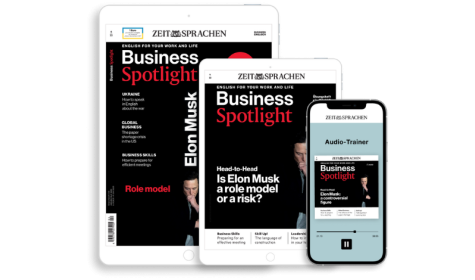Starten Sie den Audio-Text
Mit dem Audio-Player können Sie sich den Text anhören. Darunter finden Sie das Transkript.
Erin Perry: Welcome, Bob. First, tell us exactly what we mean when we talk about “hybrid working”.
Bob Dignen: Well, first let me give you the obvious answer to that. I mean hybrid working describes, I think, for many the new way of working we’ve seen to emergeentstehenemerge as a result of the pandemic. You know, part home working, part office working. Now, a relianceAbhängigkeitreliance on technology to communicate. Less face-to-facepersönlich, mit persönlichem Kontaktface-to-face communication and interaction in general. Working from distance. That’s, I think, the current definition of hybrid working. The less obvious answer to the question about what hybrid working is is to say that working has always been hybrid, has always had a remote dimension. You know, sometimes we work alone, sometimes we work with other people. Sometimes, we use technology to communicate — email, telephone. Sometimes, we talk to people in the same room. So, you know, hybrid is actually, although it’s a new term, work has always been hybrid. I guess what has changed is the ratioVerhältnisratio. We perhaps worked 10 per cent virtually, 90 per cent co-locatedan einem gemeinsamen (Stand-)Ortco-located before Covid. Under Covid, 100 per cent remotely. And now, I think we’re to swing back to sth.zu etw. zurückschwenkenswinging back to a 60 per cent remote, 40 per cent co-located model.
Perry: And what are the particular challenges of such hybrid working models?
Dignen: Aha, well, that’s the typical question that often gets asked. But before I answer that question, let’s maybe think about the more important question you didn’t ask me. Namely, you know, what are the advantages of hybrid working models? I think this is actually getting lost in the debate. And there are many —really, many, many advantages. Cost: we have reduced office space costs. Focus: we can work on our own, at our own desks, away from busy, noisy offices. There are environmental advantages: no pollution(Umwelt-)Verschmutzungpollution. And, you know, working from distance is actually an advantage sometimes, particularly for introvertIntrovertierte(r)introverts — there’s a psychological dimension to this. So, lots and lots of advantages. And I think in terms of disadvantages, well, I think that really depends. I mean clearly, it’s not for everybody psychologically. You have extravertExtrovertierte(r)extraverts, who like interaction. Also, some jobs actually do need presence. They do need co-location. You know, people have to operate machinery. Some tasks, such as building constructionBauausführung; Hochbaubuilding construction, you need more than one person in the room to lift heavy objects. You can’t play football matches virtually. So, practically, distance doesn’t work sometimes. And even on a practical level again, you know, some people don’t have the infrastructure at home to work in a hybrid way. So, you know, that’s a particular challenge. I think there are other things that are very commonly said. I’m not sure they’re true. But people say that one of the challenges of hybrid is that you can’t work so creatively together. I’m not sure about that. Some leaders particularly are worried that working in a hybrid manner will to undermine sth.etw. untergraben, beeinträchtigenundermine corporateUnternehmens-corporate culture. People aren’t going to the offices, they’re not identifying with the company in the same way any more. I’m also not sure about that. I think when we come to the challenges that I see on a day-to-day basis with my clients, one big danger, and this comes back to what I often talk about when it comes to communication, is alignmentAnpassung, Abstimmungalignment. You know, working apart, working in different locations to different rhythms, not coming together so often, working in a Teams, a virtual meeting environment, where communication is less interactive. I think there’s a greater risk of misunderstanding and assumptionAnnahmeassumptions coming into play and corrupting the collaboration which is happening. serendipityGlücksfall; hier: zufälliges ZusammentreffenSerendipity: you know, the opportunity to meet people by chance. I think that is less in a remote world. We actually do lose the corridor moment, to bump into sb.jmdm. zufällig begegnenbumping into each other, catching up on gossipKlatsch, Tratschgossip, updating quickly, giving support, all of that. In my own work, I note that, you know, finding new clients, sales, is actually difficult because building relationships with strangers remotely, I think you can do it but it’s kind of slower. You get to trust in the longer term rather than the short term. And I think the final risk, which I think is an interesting one to reflect upon, which wasn’t really on people’s minds before Covid, is well-being. Just the psychological difficulties of being alone more. Working very intensively in front of a computer screen. to cope with sth.mit etw. klarkommenCoping with work from home. All of that, I think, is emerging as a new focus for companies, to keep people healthy psychologically and physically.
Perry: What can leaders do to help make hybrid models work more effectively?
Dignen: I think there are four “Cs” that leaders need to think about to to engage sb. with sth.hier: jmdn. dazu bringen, sich mit etw. auseinanderzusetzenengage people with hybrid. One of which is very fundamental and that is “choice”: actually allowing employees some level of choice, not only in whether they work hybrid or not, but the degree to which they work hybrid. Maybe it’s one day a week, two days a week, three days a week. I think if you to impose sth. on sb.jmdm. etw. auferlegenimpose that on people, there is a real risk that you to disengage sb.jmdn. abkoppelndisengage people and you will lose that employee over time. Second “C” is “clarityKlarheit, Klarstellungclarity”, in terms of clear structure. I think the risk of fragmentation needs to be overcome with almost an over-communication. What is it that you have to do? What is it that I have to do? How are we going to communicate to make sure we’re on to be on trackauf Kurs/auf dem richtigen Weg seintrack? I think the more relaxed approach to this, which you can take in a face-to-face environment, has to give way to more structure. And I think that’s a reported experience of many people during the Covid pandemic. Thirdly, “creativity”: we need to think creatively. How can we bump into people? How can we maintain those serendipitouszufälligserendipitous opportunities just to to catch up on sth.sich über etw. auf den neuesten Stand bringencatch up on news, to offer people help? How can we get creative in a room, in a virtual room, in the same way that we can in a physical room, to bounce ideasIdeen austauschenbouncing ideas highly interactively, which is a bit more difficult in a remote environment. We need to use our imagination a bit harder than we’ve had to do historically. And I think the final “C” is about connection. Just maintaining a strong focus on empathy. to sense sth.etw. spürenSensing when people need our help, sensing when it’s right to go to the office, to connect again because people might be feeling lonely, people might be feeling frustrated, people might be moving in a different direction, they’ve lost alignment. So that kind of idea of improving our empathy skills — but I would call it our connectivity skills. So: choice, clarity, creativity and connectivity.
Perry: Finally, do you think we are likely to see a return to all — or most —staff working together in the same place?
Dignen: Short answer to that is I hope not. My own experience as a business professional, as a coach and as a trainer, you know, I would never have believed that it was possible to do a job effectively such as my own — which is very people-centric — remotely for such a long time. But (a) I see that it is and (b) I really think that there are bigger advantages, even beyond work — thinking socially, politically, environmentally — to committing to a new remote-centric hybrid model. Particularly about sustainabilityNachhaltigkeitsustainability. I mean thinking in terms of the planetaryhier: für unseren Planetenplanetary responsibility, reducing pollutingdie Umwelt verschmutzendpolluting travel and rethinking how we live in our societies. Moving away from urban centres, populating the countryside more effectively, giving people much more choice how they work, where they work. I still think there is an immense opportunity in front of us. My fear is that we’re not gonna (ifml.)going togonna take that opportunity. We’re gonna go back to what looks like the old normal. That’s my suspicionVermutung, Argwohnsuspicion, but, you know, I hope I’m wrong.
Perry: Thanks very much, Bob. We to look forward to sth.sich auf etw. freuenlook forward to talking to you again next time.
Dignen: Thank you very much.
Neugierig auf mehr?
Dann nutzen Sie die Möglichkeit und stellen Sie sich Ihr optimales Abo ganz nach Ihren Wünschen zusammen.



